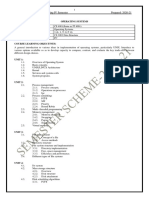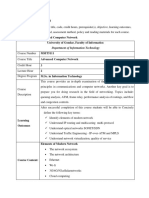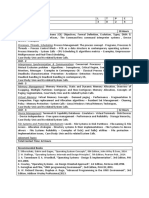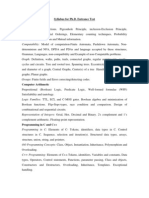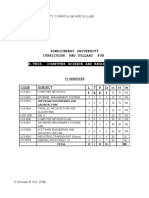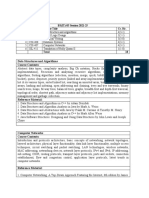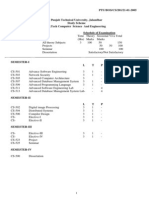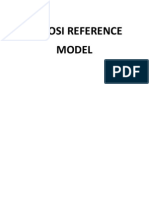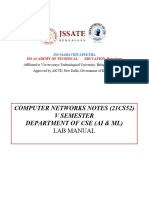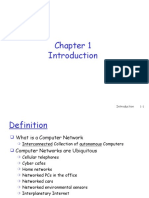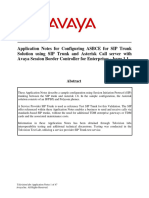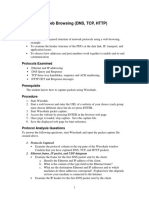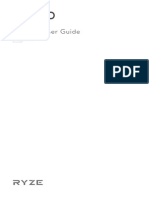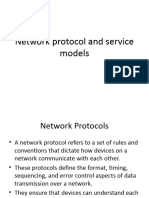CO
MAHA
S
M. Te
OMPUTE
(20
ATMA G
SCHEME
ech. DEG
ER SCIEN
013 ADMI
0
ANDHI
E AND SY
FOR
GREE PR
IN
NCE AN
ISSION O
UNIVER
YLLABI
ROGRAM
ND ENGI
ONWARDS
RSITY
I
MME
INEERIN
S)
NG
SCHEME AND SYLLABI
FOR
M.TECH DEGREE PROGRAMME
IN
COMPUTER SCIENCE AND ENGINEERING
SEMESTER II
Sl.
No
Course No.
Subjects
Hrs/ week Evaluation Scheme(Marks) Credi
ts(C ) L T P
Sessional ESE
Theor
y /
Practi
cal
Total
TA CT Sub
Total
1 MCSCS 201 Modern Database Management 3 1 0 25 25 50 100 150 4
2 MCSCS 202 Modern Computer Networks 3 1 0 25 25 50 100 150 4
3 MCSCS 203
Operating System Design
Concepts
3 1 0 25 25 50 100 150 4
4 MCSCS 204 Web Services 3 1 0 25 25 50 100 150 4
5 MCSCS 205 Elective III 3 0 0 25 25 50 100 150 3
6 MCSCS 206 Elective IV 3 0 0 25 25 50 100 150 3
7 MCSCS 207 Network Simulation Lab - - 3 25 25 50 100 150 2
8 MCSCS 208 Seminar II - - 2 50 - 50 0 50 1
Total 18 4 5 225 175 400 700 1100 25
Elective III (MCSCS 205) Elective IV (MCSCS 206)
MCSCS 205-1 Virtualization Systems MCSCS 206-1 Social Network Analytics
MCSCS 205-2 Grid Computing MCSCS 206-2 Digital Image Processing
MCSCS 205-3 Advanced Computer Architecture MCSCS 206-3 Embedded Systems
MCSCS 205-4 Parallel Algorithms MCSCS 206-4 Ontology Driven Knowledge Management
L Lecture, T Tutorial, P Practical
TA - Teachers Assessment (Assignments, attendance, group discussion, quiz, tutorial, seminar etc.)
CT - Class Test (Minimum of two tests to be conducted by the Institute)
ESE - End Semester Examination to be conducted by the University
Electives - New Electives may be added by the department according to the needs of emerging fields
of technology. The name of the elective and its syllabus should be submitted to the
University before the course is offered..
Seminar - Students may select a topic for their seminar preferably in the same area as that of their
project.
L T P C
3 1 0 4
MCSCS 201 MODERN DATABASE MANAGEMENT
Module 1
Web Databases: NoSQL Databases - MongoDB example -Semi-structured data management-
XML, XPath and XQuery, Document data-stores -Examples, Key-Value data-stores
Examples- In-memory databases-VoltDB example
Embeeded Databases - definition- Example - SQLite internal architecture and data types
Module 2
Advanced databases: Spatial Data Management: Types Of Spatial Data And Queries- Point
And Region Data-Queries-Applications Involving Spatial Data, -Spatial Indexes-indexing
using Space Filling Curves- Region Quad Trees and Z Ordering Index Structures - Grid
Files, Rtrees
Distributed databases- distributed file systems- Examples- distributed query processing-
Module 3
Next Generation Databases: Cloud Databases- methods to run- virtual machine deployment,
as a service- Column Stores-Examples- Cassandra, HBase-Aggregation and J oin, - Case
study- BigTable Googles distributed storage system for structured data-building blocks-GFS,
Scheduler, Lock Service, MapReduce
Graph databases- Comparison of Twitters FlockDB and Neo4j- Overview of NewSQL- Case
study -Google's Spanner
Module 4
Emerging Technologies:
Multimedia Databases-Multimedia Sources-Image Databases-Compressed Representations-
Similarity Based Retrieval
Mobile Databases- Mobile Database Systems-Issues and Applications-Query processing-
Query types Transaction Execution in MDS- Mobile Transaction Models -Concurrency
Control Mechanism-Transaction Commit Protocols- Mobile database Recovery: Log
management in mobile database systems
References:
1. Serge Abiteboul, Ioana Manolescu, Philippe Rigaux, Marie -Christine Rousset, Pierre
Senellart, Web Data Management, Cambridge University Press, 450 pages,2011. (also
available online)
2. Bhavani Thuraisingham, XML Databases and the Semantic Web, CRC Press, 2002.
3. Elmasri R., Navathe S.B., "Fundamentals of Database Systems",
Pearson Education/Addison Wesley, Fifth Edition, 2007.
4. Henry F Korth, Abraham Silberschatz, Sudharshan S., Database System Concepts,
McGraw Hill, Fifth Edition, 2006.
5. SQLite, FromWikipedia,the free encyclopedia,
http://en.wikipedia.org/wiki/SQLite
6. Raghu Ramakrishnan, J ohannes Gehrke, Database Management Systems, McGraw Hill,
Third Edition, 2004.
7. VoltDB The NewSQL database for high velocity applications
http://odbms.org/download/VoltDBTechnicalOverview.pdf
2
8. Dale Anderson, Big Data and NoSQL Technologies at http://dbbest.com/blog/big-data-
nosql-technologies/
9. Dale Anderson, Column Oriented Database Technologies at
http://dbbest.com/blog/column-oriented-database-technologies/
10. Big Table and Column Databases,Ling Liu,College of Computing
http://www.cc.gatech.edu/~lingliu/courses/cs4440/notes/17.BigTableColumnDB.pdf
11. Fay Chang, J effrey Dean, Sanjay Ghemawat, Wilson C. Hsieh, Deborah A. Wallach Mike
Burrows, Tushar Chandra, Andrew Fikes, Robert E. Gruber, Bigtable: A Distributed
Storage System for Structured Data at
http://static.googleusercontent.com/external_content/untrusted_dlcp/research.google.com/
en//archive/bigtable-osdi06.pdf
12. Graph databases- Ian Robinson, J im Webber, Emil Eifrem, OReilly
13. Klint Finley, 5 Graph Databases to Consider at http://readwrite.com/2011/04/20/5-graph-
databases-to-consider
14. Vijay Kumar, Mobile Database Systems, A J ohn Wiley & Sons, Inc., Publication.
4
MCSCS 202 MODERN COMPUTER NETWORKS L T P C
3 1 0 4
Module 1
Physical Layer: Data Transmission- Analog and Digital Transmission, Transmission
Impairments, Channel Capacity. Transmission Media- Wired Transmission, Wireless
Transmission, Wireless Propagation, Line-of Sight Transmission, Signal Encoding
Techniques
Data link layer: TCP/IP Protocol Architecture, Framing, Reliable Transmission, Ethernet
(802.3) and Token Ring (802.5)
Module 2
Network Layer: Connecting Devices. ARP, RARP. IP Address Sub netting / Super netting,
Packet Forwarding with Classful / Classless Addressing, Datagram Fragmentation,
Components in IP software, Private IP and NAT. ICMP. Routing Protocols -Distance Vector
Routing-RIP, Link-State Routing-OSPF
Module 3
Transport Layer: UDP- Port Addressing, UDP datagram, UDP operation. TCP- TCP
services and features, TCP segment, TCP connection, TCP state transitions, TCP modules
algorithm, Flow and Error control, Congestion control, TCP Timers. SCTP- SCTP services
and features, Packet format, SCTP connection, State Transitions, Flow and Error control.
Module 4
Application Layer: DNS- Distribution of Name Space, Name Resolution, DNS messages,
HTTP-Architecture, HTTP Transaction, DHCP - Address allocation, Packet format. SNMP-
SMI, MIB, SNMP PDUs, Real Time Data Transfer- RTP, RTCP, Voice over IP-Session
Initiation Protocol.
References:
1. William Stallings, Data and Computer Communications , Pearson Education.
2. Behrouz A Forouzan, TCP/IP Protocol Suite, Tata McGraw-Hill.
3. Peterson and Davie, Computer Networks A systems approach , Elsevier.
4. Kurose and Ross, Computer Networks A systems approach , Pearson Education.
5. Behurouz A Forouzan, Data Communications & Networking,4
th
edition, McGraw-Hill.
5
Maurice J . Bach, "The Design of the Unix Operating System", First
ngs, "Operating Systems",Fourth Edition, Pearson Education, 2004
3. Uresh Vahalia, "Unix Internals - The new Frontiers", Pearson Education, 2006
986.
MCSCS 203 OPERATING SYSTEM DESIGN CONCEPTS
L T P C
3 1 0 4
Module 1
Overview of the System - Evolution of operating system -Characteristics of modern
operating system- Traditional and Modern Unix systems-Introduction to the Kernel -
Architecture of the UNIX operating system - Introduction to system concepts - Kernel
data structures - System administration. The Buffer Cache: Buffer headers - Structure of the
buffer pool - Scenarios for retrieval of a buffer - Reading and writing disk blocks -
Advantages and disadvantages of the buffer cache.
Module 2
File Subsystems - Inode - Regular file - Directories - Conversion of a path name to an Inode
- Super block Inode assignment to a new file - Allocation of disk blocks- System Calls for
the file system: Open - Read - Write - File and record locking - Adjusting the position of file
I/O - lseek - close - File creation - Creation of special files - Changing directory, root, owner,
mode - stat and fstat - Pipes - Dup - Mounting and unmounting file systems - link- unlink -
File system abstraction and maintenance
Module 3
Processes - Process states and models - Process context - Manipulation of the process
address space -Sleep- Process Control - Process creation - Signals - Process termination -
Invoking other programs - user id of a process - Changing the size of a process - Shell -
System boot and the INIT process- Process Scheduling-Unix concurrency mechanisms-
Distributed Process Management Process migration-Distributed Mutual Exclusion
Module 4
Memory Management -Swapping - Demand paging - Hybrid System- I/O Subsystem -
Driver Interface - Disk Drivers - Terminal Drivers- Streams - Inter process communication-
Process tracing - System V IPC - Network Communications - Sockets.
References:
1. Edition, Prentice
Hall of India, 1986.
2. William Stalli
4. B. Goodheart, J . Cox, "The Magic Garden Explained", Prentice Hall of India, 1
5. S. J . Leffler, M. K. Mckusick, M. J . .Karels and J . S. Quarterman., "The Design
And Implementation of the 4.3 BSD Unix Operating System", Addison Wesley, 1998
6
MCSCS 204 WEB SERVICES L T P C
3 1 0 4
Module 1:
es Introduction to Web Services , Web Services Architecture, Web Services
tomy of a SOAP Message, SOAP Encoding, SOAP Message Exchange Model,
atomy of a WSDL Definition Document, WSDL Bindings, WSDL Tools
tering as
essing and Data Binding with Java APIs - Extensible Markup Language
essaging Using JAXM and SAAJ - The Role of J AXM in Web Services, J AXM
Nagappan, Robert Skoczylas,Rima Patel Sriganesh, Developing J ava Web
ing, Michael D
Web Servic
Communication Models, Implementing Web Services.
Module 2:
SOAP- Ana
SOAP Communication, SOAP Messaging, SOAP Bindings for Transport Protocols, SOAP
Security, Building SOAP Web Services, Developing SOAP Web Services Using J ava
Module 3:
WSDL- An
UDDI- UDDI Registries, Programming with UDDI, Implementations of UDD, Regis
a Systinet, UDDI Registry User ,Publishing Information to a UDDI Registry, Searching
Information in a UDDI Registry,Deleting Information from a UDDI Registry
Module 4:
XML Proc
(XML)Basics, J ava API for XML Processing (J AXP), J ava Architecture for XML Binding
(J AXB)
XML M
API Programming Model, Basic Programming Steps for Using J AXM, J AXM Deployment
Model, Developing J AXM-Based Web Services
References:
1. Ramesh
Services, Wiley Publishing Inc.,2003.
2. Richard Monson Haefel, J 2EE Web Services, Pearson Education, 2004.
3. Travis Vandersypen, J ason Bloomberg, Madhu Siddalingaiah, Sam Hunt
Qualls, David Houlding, Chad Darby, Diane Kennedy, XML and Web Services
Unleashed, Pearson Education, 2002.
4. Frank P Coyle, XML Web Services and Data Revolution, Pearson Education, 2002.
5. Mark Hansen, SOA Using J ava Web Services, Pearson Education, 2007.
7
CSCS 205-1 VIRTUALIZATION SYSTEMS
odule 1:
Why server virtualization History and re-emergence General structures.
s comparison. Commercial solutions VMWare, Xen.
anagement in virtualization: partitioning reclamation ballooning. Memory
-level virtualization VM Ware Red Hat Enterprise Virtualization.
ization: Virtualizing I/O devices -monolithic model -virtual I/O server. Virtual
tunneling overlay networks. Commercial examples. Virtual storage: Granularity
computing: Virtual machine based distributed computing, elastic cloud
l Machines: Versatile Platforms for Systems and Processes (1st Ed): J im Smith,
models for IT professionals and Software
L T P C
M
3 0 0 3
M
Overview:
Architecture
Virtual machines: CPU virtualization -Privileged instructions handling -Hypervisor -
Paravirtualization. Hardware-assisted virtualization. Booting up. Time keeping. CPU
scheduling. Commercial examples
Module 2:
Memory m
sharing. OS
Module 3:
I/O virtual
networking
-file system level blocks level.
Module 4:
Virtualized
computing, clustering, cold and hot migration. Commercial examples. Challenges and future
trends.
References:
1. Virtua
Ravi Nair; Morgan Kaufmann (2005)
2. Applied Virtualization Technology - Usage
Developers (1st Ed): Sean Campbell Intel Press (2006).
8
MCSCS 205-2 GRID COMPUTING
odule 1:Grid Computing
Introduction -Definition -Scope of grid computing. Grid computing model- Grid Protocols
key elements Role in enterprise computing infrastructure.
omputing anatomy Grid Computing
s: Merging the Grid services Architecture with the
OGSA platform components OGSI OGSA Basic Services.
ents: Managing grids management reporting monitoring
vel services OGSI .Net
ig Fellenstein, Grid Computing, PHI, PTR-2003.
bbas, Grid Computing: A Practical Guide to technology and Applications,
2004.
2003.
(Unit 5).
L T P C
3 0 0 3
M
Desktop grids: Characteristics
Data grids: Avaki Data Grid Data grid Architecture.
Module 2:Grid Computing Initiatives
Grid Computing Organizations and their roles Grid C
road map. Grid Computing Application
Web Services Architecture.
Module 3:Technologies
OGSA Sample use cases
Managing Grid Environm
service level management data catalogs and replica management.
Module 4:Grid Computing Tool Kits
Globus GT3 Toolkit Architecture, Programming model, High le
middleware Solutions.
References:
1. J oshy J oseph & Cra
2. Ahmar A
Charles River media 2003.
3. Ian Foster, Carl Kesselman, The Grid2: Blueprint for a New Computing Infrastructure.
Morgan Kaufman, New Delhi,
4. Fran Bermn, Geoffrey Fox, Anthony Hey J .G., Grid Computing: Making the Global
Infrastructure a Reality, Wiley, USA,
5. Maozhen Li, Mark Baker, The Grid: Core Technologies, J ohn Wiley & Sons, 2005.
6. URLs: www.globus.org and glite.web.cern.ch
9
CSCS 205-3 ADVANCED COMPUTER ARCHITECTURE
echnologies - Memory Hierarchy, Cache memory-generic cache o
, mapping techniques , instruction caches and unified caches , performance
Y86 instruction set architecture, sequential Y-86 implementations,
rocessing into stages, sequential hardware structure, sequential timing, sequential
Program Performance - Capabilities and limitations of optimizing compilers,
loop inefficiencies, reducing Procedure calls, Eliminating unneeded memory
Program Execution Time - Flow of time on a computer system, process
nd timer interrupts, measuring time by interval counting, operation, reading the
eferences:
l E bryant and David O'Hallaron Computer Systems A programmer's
ctive Pearson Education
dvanced Computer Architecture 2nd edition Tata
Mcgraw-Hill
L T P C
M
3 0 0 3
Module 1:
Storage T
organization
mem ry
impact of cache parameter, writing cache-friendly code. Virtual memory, virtual memory as a
tool for caching, case study of Pentium/Linux memory system-Pentium address translation,
Linux Virtual memory system, memory mapping, dynamic memory allocation, garbage
collection- garbage collector basics, mark & sweep garbage collector.
Module 2:
Processor Architecture -
organizing p
stage implementations, General principles of pipelining, Pipelined Y86 implementation.
Module 3:
Optimizing
Eliminating
reference, reducing loop overhead, converting to pointer code, enhancing Parallelism -loop
splitting, register spilling, limits of parallelism, Branch prediction and misprediction penalties
, memory performance, performance bottlenecks.
Module 4:
Measuring
scheduling a
processor timers, accuracy of processor timers, IA32 cycle counters, measuring program
execution time with cycle counter. Concurrent programming with processes, Concurrent
program with Threads
R
1. Randa
perspe
2. Kaihwang and Naresh J otwani, A
3. . Hennessy J .L and David A. Patterson Computer Architecture- A Quantitative
Approach Elsevier Publication
Advanced Computer Architecture: A Design Space 4. Sima D,Fountain T and Kacsuk P
ApporachPearson Education
10
CSCS 205-4 PARALLEL ALGORITHMS
odule 1:
el - PRAM Algorithms Parallel Reduction Prefix Sums List Ranking Preorder
al Merging Two Sorted Lists Graph Coloring Reducing Number of Processors
orithms - Hypercube SIMD Model Shuffle Exchange SIMD Model
MD Model UMA Multiprocessor Model Broadcase Prefix Sums.
- Lower Bound on Parallel Sorting Odd-Even Transposition Sort Bitonic
plexity of Parallel Search Searching on Multiprocessors Elliss Algorithm
e- Quicksort, OpenMP Synchronization Issues
arch - Breadth Death Search Breadth First Search Connected Components All
t Path Single Source Shortest Path Minimum Cost Spanning Tree Sollins
Quinn, Parallel Computing : Theory & Practice, Tata McGraw Hill Edition,
d Edition, 2008.
Addison Wesley, 2003
L T P C
M
3 0 0 3
M
PRAM Mod
Tree Travers
Module 2:
Classifying MIMD Alg
2D Mesh SI
Matrix Multiplication on 2-D Mesh, Hypercube and Shuffle Exchange SIMD Models
Algorithms for Multiprocessors Algorithms for Multicomputers
Module 3:
Enumeration Sort
Merge Com
Manber and Ladners Algorithm
OpenMP- Introduction, The OpenMP for Pragma- Dijkstra Shortest-Path Algorithm with
Parallel for Loops, Task Directiv
Module 4:
P-Depth Se
pair Shortes
Algorithm Kruskals Algorithm
References:
1. Michael J .
Secon
2. Ananth Grame, George Karpis, Vipin Kumar and Anshul Gupta, Introduction to Parallel
Computing, 2nd Edition,
3. Norm Matlo, Programming on Parallel Machines, University of California
11
MCSCS 206-1 SOCIAL NETWORK ANALYTICS
odule 1:Social Media Defined
social media examples The Network perspective types
metrices Bounce rate Exit rate Conversion
etrics A Web Analytics Primer Understanding
s) Moving beyond Conversion Rates Measuring Macro
ing Success for a Non-ecommerce Website Lab Usability
ompetitive Intelligence Data Sources, Types, and Secrets Website
and Keyword Analysis Audience Identification and Segmentation
L T P C
3 0 0 3
M
Social media design framework
of networks
Module 2: Web Analytics 2.0 paradigm
Clickstream Analysis Eight critical web
rate Engagement Attributes of great m
Visitor Acquisition Strengths Click Density Analysis Measuring Visits to Purchase
Search Engine Optimization (SEO) Analysis Direct Traffic Analysis
Module 3: Measuring outcome
Key Performance Indicators (KPI
and Micro Conversions Measur
tests Surveys Types of Surveys
Module 4: A/B Testing
Multivariate Testing C
Traffic Analysis Search
Analysis
References:-
1. Derek L. Hansen,Ben Sheiderman, ,Marc A. Smith, .AnalyzingSocial
MediaNetworkswith NodeXL, Morgan Kaufmann, 2011
2. Avinash Kaushik. 2009. Web Analytics 2.0, Wiley Publishing, Inc, 2010.
12
MCSCS 206-2 DIGITAL IMAGE PROCESSING L T P C
3 0 0 3
odule 1
n to Digital Image Processing, fundamental steps in Digital Image Processing,
g
2
frequency domain: preliminary concepts, Fourier transform of sampled functions,
nd multiresolution processing: Image pyramids, subband coding, the Haar
ast
ls
entation: point, line, and edge detection, thresholding, region based segmentation;
lez R. C. & Woods R. E., Digital Image Processing, 3
rd
ed, PHI Learning, 2008.
2. Sonka M, Vaclav Hlavac, and Roger Boyle, n , Analysis and Machine
M
Introductio
elements of visual perception, image sensing and acquisition, sampling and quantisation,
relationship between pixels, intensity transformations and spatial filtering: basic intensity
transformation functions, histogram processing, spatial filtering, smoothing and sharpenin
filters.
Module
Filtering in
Discrete Fourier Transform of one and two variables, Fast Fourier Transform, filtering in the
frequency domain: smoothing and sharpening filters, Image restoration: noise models,
restoration in the presence of noise only, periodic noise reduction.
Module 3
Wavelets a
transform, multiresolution expansions, wavelet transform in one and two dimensions, f
wavelet transform, wavelet packets. Image compression: fundamentals, compression mode
and standards, basic compression methods: Huffman coding, Golomb coding, arithmetic
coding, LZW coding, run-length coding, wavelet coding.
Module 4
Image segm
representation, boundary descriptors, regional descriptors.
References:
1. Gonza
Image Processi g
Vision, Brooks Cole, 3
rd
ed, 2008
3. J ain A K, Fundamentals of Digital Image Processing, Prentice-Hall India, 2007.
13
CSCS 206-3 EMBEDDED SYSTEMS L T P C M
Module 1
3 0 0 3
n to Embedded Systems: Definition, Characteristics and Classification Overview
f Processors and hardware units in an embedded system Software embedded into the
d Buses for Devices Network: I/O Devices -Device I/O Types and Examples
ynchronous -Iso-synchronous and Asynchronous Communications from Serial Devices -
Programming: Programming in assembly language (ALP) vs. High Level
anguage -C Program Elements, Macros and functions -Use of Pointers -NULL Pointers -Use
n calls in a Cyclic Order in the Main Function Pointers Function Queues
nd Interrupt Service Routines Queues Pointers Concepts of EMBEDDED
odule 4
Systems Part -1 OS Services Interrupt Routines Handling, Task
cheduling models -Handling of task scheduling and latency and deadlines as performance
E. Simon, An Embedded Software Primer, Pearson Education Asia, First
Indian Reprint 2000.
man Publishers, 2008.
ate Reference, Dreamtech Press,2004
Introductio
o
system Embedded System design process- Exemplary Embedded Systems.
Module 2
Devices an
S
Examples of Internal Serial-Communication Devices -UART and HDLC - Parallel Port
Devices - Sophisticated interfacing features in Devices/Ports-Timer and Counting Devices -
12C, USB, CAN and advanced I/O Serial high speed buses- ISA, PCI, PCI-X, cPCI and
advanced buses.
Module 3
Embedded
L
of Function Calls
Multiple functio
a
PROGRAMMING in C++-Objected Oriented Programming Embedded Programming in
C++, C Program compilers
Cross compiler Optimization of memory codes.
M
Real Time Operating
s
metrics -Inter Process Communication And Synchronisation Shared data problem Use of
Semaphore(s) Priority Inversion Problem and Deadlock Situations Inter Process
Communications using Signals Semaphore Flag or mutex as Resource key Message
Queues Mailboxes Pipes Virtual (Logical) Sockets RPCs.
References:
1. David
2. Wayne Wolf Computers as Components: Principles of Embedded Computing System
Design, Morgan Kauf
3. Rajkamal, Embedded Systems Architecture, Programming and Design, TATA McGraw
Hill, First reprint 2003.
4. Dr. Prasad K. V. K. K., Embedded / Real-Time systems: Concepts, Design and
Programming: The Ultim
14
6-4ONTOLOGY DRIVEN KNOWLEDGE MANAGEMENT
Se
ing Semantic search- Linked Data-Vocabularies,
RDF triple form- RDF Graph-simple examples-
deas, Language- Exchanging Information With RDF,
ogics- A
in a Knowledgebase , Realizing the
ce , Understanding Backward
MCSCS 20 L T P C
3 0 0 3
Module 1: Foundations of Semantic Web
Todays web and keyword based search, Semantic Web, Examples, mantic web
technologies- Sources of semantic Data- us
Taxonomies and Ontologies - Overview of Ontology Elements Requirements of ontology
languages, Examples of published Ontology- Semantic Web versus Artificial Intelligence, A
Layered approach to Semantic Web
Module 2: Modeling Information
Resource Description Framework
advantages-RDF Schema- Basic I
Statements As Points, RDF Serializations , RDF/XML, Blank Nodes In RDF, Reication, ,
Limitations Of RDF Schema, RDFS entailment -SPARQL- Simple Query Example
Module 3: Knowledge Representation
Web Ontology Language OWL, Examples- Sublanguages-OWL DL- Description L
Box T Box split
Predicate Logic and Rule Systems, Horn Logic-Monotonic Rule Systems, Non Monotonic
Rule- Systems -Rule Languages- RuleML,SWRL,ORL
Module 4: Logic and Inference
Semantic Web Frameworks , Retrieving Information
Semantics of OWL , Understanding Forward Chaining Inferen
Chaining Inference , Choosing the Right Inference Method- Common Frameworks and
Components- J ena, Seasme - RDF store implementations-Retrieval Components-Reasoning
Engines
References:
1. Grigoris Antoniou and Frank van Harmelen. A Semantic Web Primer, MIT Press,2004.
2. J ohn Hebeler, Matthew Fisher, Ryan Blace, Andrew Perez-Lopez, Semantic Web
Programming, Wiley Publishing, Inc, 2009.
3. Thomas B. Passin,Explorer's Guide to the Semantic Web, Manning, Pearson, J uly 2004.
4. J ohn Davies, Dieter Fensel, Towards the Semantic Web: Ontology-driven Knowledge
management,J ohn Wiley& Sons Ltd, 2003.
5. Davies, J ohn, Rudi Studer, and Paul Warren, Semantic Web Technologies : Trends and
Research in Ontology-Based Systems, J ohn Wiley & Sons, 2006.
6. Bhavani Thuraisingham, XML Databases and the Semantic Web, CRC Press, 2002.
7. Dieter Fensel, J ames A. Hendler, Henry Lieberman and Wolfgang Wahlster, Spinning the
Semantic Web- Bringing the World Wide Web to Its Full Potential, MIT Press, 2002
8. The Fundamental Importance of Keeping an ABox and TBox Split,Ontology Best
Practices for Data-driven Applications: Part 2,
http://www.mkbergman.com/489/ontology-best-practices-for-data-driven-applications-
part-2/
9. Toby Segaran,Colin Evans,J amie Taylor, Programming the semantic web, OReilly, J uly
2009
15
MCSCS 207 NETWORK SIMULATION LAB L T P C
List of Experiments:
0 0 3 2
f cket capturing tool called WireShark.
ples
using NS2 and then
ired network environment using
nt variants of TCP (Tahoe, Reno, Vegas.) in wired
reless Ad hoc networks using NS2
d UDP Traffic using NS2 and then
outing protocols (DSDV, DSR,
m-Wireless networks and MobileIP Simulations using NS2
1. A thorough study o pa
2. Familiarizing Network Simulator 2 (NS2) with suitable exam
3. Simulate a wired network consisting of TCP and UDP Traffic
calculate their respective throughput using AWK script.
4. Performance evaluation of different routing protocols in w
NS2
5. Performance evaluation of different queues and effect of queues and buffers in wired
network environment using NS2
6. Compare the behavior of differe
network using NS2. Comparison can be done on the congestion window behavior by
plotting graph.
7. Simulation of wi
8. Simulate a wireless network consisting of TCP an
calculate their respective throughput using AWK script.
9. Performance evaluation of different ad-hoc wireless r
AODV ) using NS2
10. Create different Wired-cu
16
MCSCS 208 SEMINAR II
Each student shall present a seminar on any topic of interest related to the core / elective
L T P C
- - 2 1
courses offered in the first semester of the M. Tech. Programme. He / she shall select the topic
based on the References: from international journals of repute, preferably IEEE journals. They
should get the paper approved by the Programme Co-ordinator / Faculty member in charge of
the seminar and shall present it in the class. Every student shall participate in the seminar. The
students should undertake a detailed study on the topic and submit a report at the end of the
semester. Marks will be awarded based on the topic, presentation, participation in the seminar
and the report submitted.
